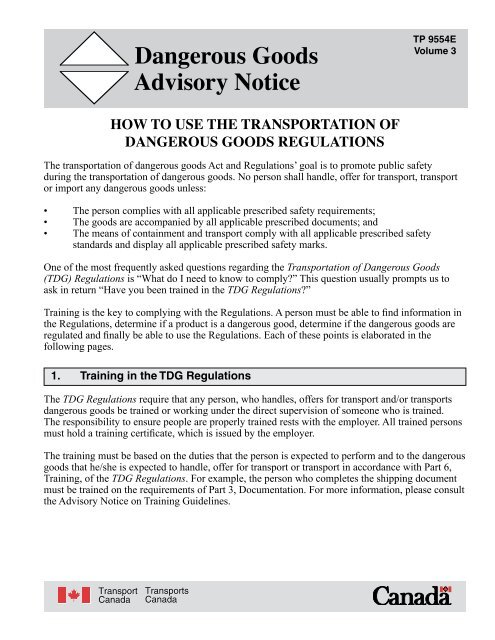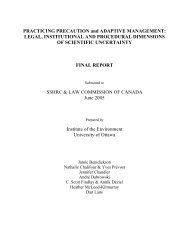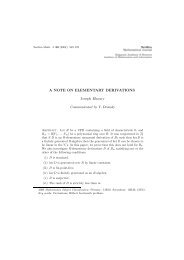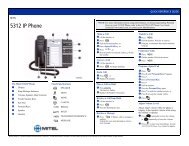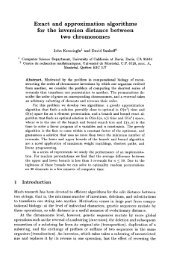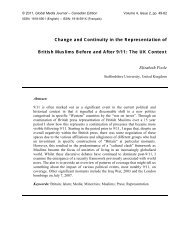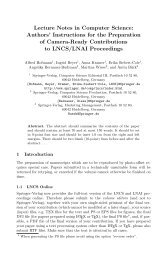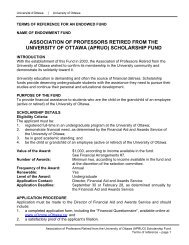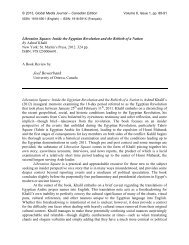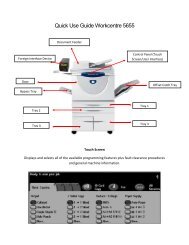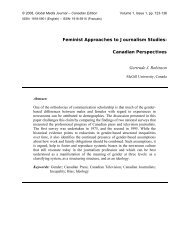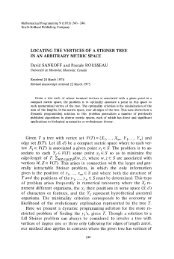PDF Version, 413 kb - Transports Canada
PDF Version, 413 kb - Transports Canada
PDF Version, 413 kb - Transports Canada
You also want an ePaper? Increase the reach of your titles
YUMPU automatically turns print PDFs into web optimized ePapers that Google loves.
Dangerous GoodsAdvisory NoticeTP 9554EVolume 3HOW TO USE THE TRANSPORTATION OFDANGEROUS GOODS REGULATIONSThe transportation of dangerous goods Act and Regulations’ goal is to promote public safetyduring the transportation of dangerous goods. No person shall handle, offer for transport, transportor import any dangerous goods unless:• The person complies with all applicable prescribed safety requirements;• The goods are accompanied by all applicable prescribed documents; and• The means of containment and transport comply with all applicable prescribed safetystandards and display all applicable prescribed safety marks.One of the most frequently asked questions regarding the Transportation of Dangerous Goods(TDG) Regulations is “What do I need to know to comply?” This question usually prompts us toask in return “Have you been trained in the TDG Regulations?”Training is the key to complying with the Regulations. A person must be able to find information inthe Regulations, determine if a product is a dangerous good, determine if the dangerous goods areregulated and finally be able to use the Regulations. Each of these points is elaborated in thefollowing pages.1. Training in the TDG RegulationsThe TDG Regulations require that any person, who handles, offers for transport and/or transportsdangerous goods be trained or working under the direct supervision of someone who is trained.The responsibility to ensure people are properly trained rests with the employer. All trained personsmust hold a training certificate, which is issued by the employer.The training must be based on the duties that the person is expected to perform and to the dangerousgoods that he/she is expected to handle, offer for transport or transport in accordance with Part 6,Training, of the TDG Regulations. For example, the person who completes the shipping documentmust be trained on the requirements of Part 3, Documentation. For more information, please consultthe Advisory Notice on Training Guidelines.Transport<strong>Canada</strong><strong>Transports</strong><strong>Canada</strong>
2. Finding information in the TDG RegulationsThe TDG Regulations are broken down into 16 parts and three schedules. The parts provide theregulatory requirements for the transportation of dangerous goods. The schedules provideadditional information that complements the parts.PARTSPART 1PART 2PART 3PART 4PART 5PART 6PART 7PART 8PART 9PART 10PART 11PART 12PART 13PART 14PART 15PART 16SCHEDULESSCHEDULE 1SCHEDULE 2SCHEDULE 3TITLEComing into Force, Repeal, Interpretation, General Provisions andSpecial Cases (definitions of words and terms and exemptions)Classification (the criteria for the nine classes)Documentation (information required and location of documents)Dangerous Goods Safety Marks (labels, placards, signs and othersafety marks)Means of ContainmentTrainingEmergency Response Assistance PlanAccidental Release and Imminent Accidental Release Report RequirementsRoadRailMarineAirProtective DirectionPermit for Equivalent Level of SafetyCourt OrderInspectorsTITLEClasses 1 to 9 (list of dangerous goods)Special ProvisionsAlphabetical Index3. Determining if a Product is a Dangerous GoodIt is the consignor’s responsibility to classify a substance, product or organism to determineif it is a dangerous good. There are two ways to classify goods:• Schedule 1 - Classes 1 to 9, or• Part 2 - Classification.Schedule 1 lists the dangerous goods by UN number and provides information on all classes ofdangerous goods, such as, classification, quantity exemptions and limitations, special provisions andemergency response plans.Part 2, Classification, defines the criteria of the nine classes of dangerous goods and is usuallyreferred to when the dangerous goods are not listed by name in Schedule 1, Classes 1 to 9.Always refer to Schedule 1, Classes 1 to 9, first. Find the UN Number of the dangerous goods underColumn 1 in Schedule 1, Classes 1 to 9. If the UN number is not known, refer to the shipping namesalphabetical index in Schedule 3 to search the UN number.2
Forbidden Dangerous GoodsSchedule 3 lists the dangerous goods shipping names in alphabetical order. It includes dangerousgoods that are forbidden for transport. Schedule 1 also forbids dangerous goods from beingtransported when the word “forbidden” is shown in column 3, class.4. Determining if Dangerous Goods are regulatedVerify if any special provision numbers are present under Column 5 of Schedule 1. Specialprovisions are found in Schedule 2, and may provide an exemption from certain parts or sectionsof the Regulations.If there are no special provisions in Schedule 2 exempting dangerous goods, verify sections 1.15to 1.48 - Special Cases in Part 1. Some of the exemptions are partial, that is, they may be exemptfrom certain sections or parts of the Regulations with some conditions. The conditions of theexemption must be strictly adhered to, if not, the Regulations apply entirely.For example section 1.25 states:“These Regulations do not apply to dangerous goods that are transported solelywithin a manufacturing or processing facility to which public access is controlled.”If there are no exemptions in Schedule 2 - Special Provisions or Part 1 - Special Cases, thedangerous goods are fully regulated.Modal RequirementsParts 9, 10, 11 and 12 deal specifically with a mode of transport, respectively, road, rail, marine andair.PermitsPermits may also allow a relief from certain requirements of the Act and the Regulations. Theconditions of the permit must be strictly adhered to. Two types of permit exist:• Permit for Equivalent (when conducting an activity in a manner that is as safeLevel of Safety 1or safer than complying with the Act and Regulations)• Emergency Permit (when dealing with an emergency in which there is adanger to public safety)1Application for a permit is made to the Minister or a designated person (Transport Dangerous Goods Directorate, Transport<strong>Canada</strong>)3
5. Using the RegulationsThe Regulations apply to dangerous goods if they are not exempted in Schedule 2 - SpecialProvisions or Part 1 - Special Cases. In addition to training, classification, special provisions andspecial cases, the following requirements of the Regulations also apply.• Filing an emergency response plan with the TDG Directorate for all dangerous goods to betransported or imported in quantities greater than those specified in Column 7 of Schedule 1.The products, for which a quantity is specified, in Column 7 are the ones that are considered mostdangerous. The requirements to file an emergency response plan are found in Part 7.• Determining the mode of transport. Refer to Parts 9, 10, 11 and 12 for requirementsspecific to road, rail, marine and air transport.• Determining the allowable quantity per means of transport for passenger carrying ship,passenger road and railway vehicle in columns 8 and 9 of Schedule 1. There are no quantitylimits for other means of transport (i.e. cargo shipments).• Selecting the appropriate means of containment for the dangerous goods as required in Part 5.Refer to the Means of Containment Advisory Notice.• Displaying the dangerous goods safety marks required in Part 4 (i.e. labels, proper shippingname, UN number). Refer to the Safety Marks Advisory Notice.• Completing the shipping document in accordance with the requirements found in Part 3. Refer tothe Shipping Document Advisory Notice.Accidental Release and Imminent Accidental Release Report RequirementsAny accidental release and imminent accidental release as specified in Part 8 must be reported bythe person having possession of the goods. There is also a requirement for the employer to completea follow-up report within 30 days.This advisory notice was produced to facilitate understanding of the TDG Regulations.For specific information, the Act and Regulations must be consulted.4


